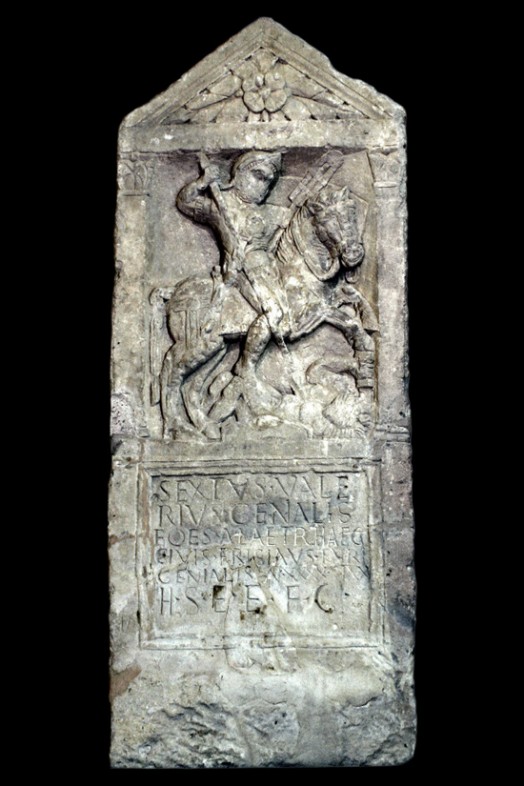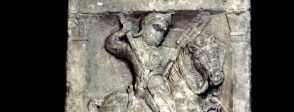
The value of tombstones
Tombstones are a very important source of information about the Roman army in Britain. If the stones are carved with figures, we can learn about personal appearance, equipment, badges of rank and how the dead wanted to be represented. As most tombstones carry inscriptions, we are also able to find out about who the soldiers were, the different army units, how they were organised, who commanded them, whereabouts in Britain they were stationed as well as matters such as length of service and lifespan.
What this tombstone shows
This tombstone was found at Corinium which was established as a Roman fort in the early days of the Roman occupation of Britain after the invasion of AD 43 and later became an important town and capital of the Roman presence in the west of England. Genialis, the soldier whose grave this marked, died around AD 60, before the establishment of Corinium as a town and could have been among the first wave of Roman invaders. On the tombstone Genialis is shown on horseback, riding down a barbarian warrior whose body lies crumpled along the bottom of the panel, still clutching his sword, his nakedness contrasting with the heavy armour of Genialis. Genialis wears a helmet, body armour decorated with the head of Medusa and a long sword at his belt. He carries a spear in his right hand and a shield in his left. You can also see his horse’s harness and its trappings decorated with discs and fringes. Genialis carries what is thought to be some sort of standard on a pole. This scene of a horseman trampling the enemy is common on Roman and earlier Greek military tombstones and symbolises the superiority and victory of Genialis over his foes.
Diversity in the Roman army
The inscription provides more detail about the dead man. His full name was Sextus Valerius Genialis and he served in a regiment of cavalry from Thrace, in what is now Bulgaria, close to Turkey and the Black Sea. Genialis himself though was a Frisian, from the area that is now the Netherlands. He was forty years old when he died and had served twenty years in the army. You can find the full inscription and translation in For the classroom.
When thinking about the Roman army, it is easy to concentrate on the legions, the heavily armed infantry with their javelins, short swords and oblong shields. However, a legion was supplemented by units of auxiliary troops who provided additional infantry and specialist soldiers such as archers, slingers and cavalry. Originally auxiliary units were made up of native allies of Rome commanded by their own chiefs, but were later recruited deliberately from the provinces of the empire and given a formal command structure. Whereas a legionary had to be a Roman citizen, it was Roman citizenship that was the reward for auxiliary soldiers discharged after serving 25 years. Sadly, Genialis died five years short of achieving his citizenship.
The tombstone of Genialis is a very good demonstration of the cultural diversity of the Roman empire. A Germanic man was recruited into a cavalry regiment initially created from east Europeans living near the Black Sea. His regiment then fought for the Romans during the invasion of Britain, where he died and had his grave. His tombstone was carved in stone from the west of England, but shows a distinctively Graeco-Roman scene and was inscribed in Latin, the language of the Romans. It is intriguing to wonder who actually carved the scene and inscription, as the word for Thracian is mis-spelled.
More information
Information packs for teachers
Teacher packs from Corinium Museum with information about the town and other aspects of life in Roman Britain and about a similar tombstone for another cavalryman named Dannicus.
http://coriniummuseum.files.wordpress.com/2013/06/everyday-life-of-the-romans-doc1.pdf
The Roman army in pictures
A British Museum article on the Roman army with images to click through.
http://www.britishmuseum.org/explore/highlights/articles/r/the_roman_army.aspx
The Roman army
An article on the Roman army from BBC History.
http://www.bbc.co.uk/history/ancient/romans/romanarmy_gallery_03.shtml
The Romans
BBC History pages on the Romans.
http://www.bbc.co.uk/history/ancient/romans/
About Romanisation
Article on Romanisation from BBC History.
http://www.bbc.co.uk/history/ancient/romans/romanisation_article_01.shtml
More information
-
Information packs for teachers
Teacher packs from Corinium Museum with information about the town and other aspects of life in Roman Britain and about a similar tombstone for another cavalryman named Dannicus.
Source: Corinium Museum
-
The Roman army in pictures
A British Museum article on the Roman army with images to click through.
Source: britishmuseum.org
-
The Roman army
An article on the Roman army from BBC History.
Source: bbc.co.uk
-
The Romans
BBC History pages on the Romans.
Source: bbc.co.uk
-
About Romanisation
Article on Romanisation from BBC History.
Source: bbc.co.uk


